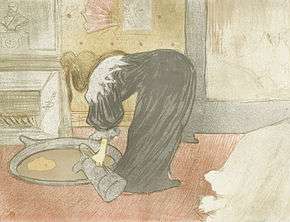Gustave Pellet
Gustave Pellet (1859–1919) was a French publisher of art. He is best known for publishing prints of erotic artworks by Henri de Toulouse-Lautrec and Louis Legrand.

Life and work
Gustave Jean Baptiste Xavier Pellet was born to a wealthy family. His spend his youth traveling and collecting art books.[1] When the family fortune disappeared in a financial crash in 1886, Pellet decided, with a part of his book collection, to open a library in the Quai Voltaire in Paris.[2] Pellet became a publisher of art books and fine art prints in 1887.[3][4][5] He then moved to 51, Rue le Peletier, also in Paris.[6] Pellet owned the rights to the artworks of Félicien Rops, whose watercolour paintings and drawings he published in a book of a hundred plates engraved by Albert Bertrand, some in colour.[6]
Among Pellet's artists were the post-impressionist painters Henri de Toulouse-Lautrec[4] and Paul Signac.[3] However, the artist that Pellet is best known for, and who he was the first to publish,[6] is the engraver Louis Legrand.[7] Artworks such as proof prints published by Pellet were often marked with his distinctive red monogram stamp.[6][8]
The artworks were often erotic,[7] both Toulouse-Lautrec and before him Legrand making detailed studies of the night life of late nineteenth-century Paris.[9] For example, the 1896 Elles ("Women") was a series of ten Toulouse-Lautrec lithographs and a frontispiece, which Pellet had printed on high quality wove paper, in a small edition of only 100; the paper was left deckle edged, and was specially watermarked "G. Pellet / T. Lautrec"; the women are mostly from Paris brothels, and they are shown relaxing, washing and dressing.[9] Pellet inscribed the Elles prints in the lower right corner in pen with brown ink.[10]
Pellet published three volumes, Livre d'Heures, La Faune Parisienne, and Poèmes à l'Eau-forte (1914), illustrated by Legrand. He published twenty volumes by Toulouse-Lautrec from 1892 onwards. Alongside his book publishing, Pellet also published individual lithographs by artists including Paul Signac, Georges Redon, Maximilien Luce, and Louis Anquetin.[6]
References
- Victor Arwas (1978). Belle époque: posters & graphics. Academy Editions. p. 29. Retrieved 19 May 2013.
- Legrand, Louis (2006). Arwas, Victor (ed.). Louis Legrand : catalogue raisonné. London: Papadakis. ISBN 1901092712.
- "Gustave Pellet". 14 artworks. The Metropolitan Museum of Art. Retrieved 2013-05-12.
- "Gustave Pellet". Henri de Toulouse-Lautrec. Museum of Modern Art (MoMA). 2013. Retrieved 2013-05-12.
- "Gustave Pellet". Works of Henri de Toulouse-Lautrec. Art Institute Chicago. Retrieved 2013-05-12.
- Lugt, Fritz. "Pellet, Gustave". Les Marques de Collections de Dessins et d'Estampes (in French). Fondation Custodia. Retrieved 2013-05-12.
- Arwas, Victor (1978). "Louis Legrand". Armstrong Fine Art. Retrieved 2013-05-10.
- "Louis Legrand". Campbell Fine Art. 2009–2013. Retrieved 2013-05-12.
- Donson, Theodore B. (1982). Great Lithographs by Toulouse-Lautrec. Courier Dover. p. xiv. ISBN 0-486-24359-1.
- Art Institute of Chicago (2003). Graphic Modernism: selections form the Francey and Dr. Martin L. Gecht Collection at the Art Institute of Chicago. Hudson Hills. p. 26. ISBN 0865592071.
Bibliography
- Exsteens, Maurice (1962). Archives de la Maison Gustave Pellet. Bern: Klipstein et Kornfeld.